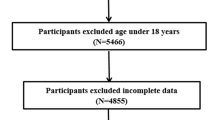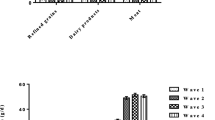Abstract
Studying dietary patterns and its relation to the development of various chronic diseases have received much interest during the past years, since they capture a holistic approach of true diet. Haptoglobin (Hp) has been associated with cardiovascular heart disease risk especially with acute myocardial infarction, coronary and peripheral artery disease, stroke, and heart failure. This study aimed to evaluate the relationship between dietary patterns and Hp blood levels among apparently healthy adults. During 2009, 490 volunteers (46 ± 16 years, 40 % male) were consecutively enrolled to the study (participation rate 85 %). Biochemical analyses were performed through established procedures, after 12 h fasting. Anthropometric, lifestyle and dietary characteristics were also recorded to account for potential confounders. Principal components analysis (PCA) was the data-driven technique to extract the dietary patterns. Pattern analysis revealed eight dietary patterns through the application of PCA; however, four of them were considered nutritionally important as they explained 35 % of total variance in food consumption (“Western diet”, “Mediterranean diet”, “Meat and bakery products” and “Alcohol and stimulants pattern”). The fourth pattern (alcohol and stimulants intake) has been characterised by intake of alcoholic drinks (wine, beer, and spirits) and stimulants (coffee and tea). Adherence to the latter pattern was associated with reduced Hp levels (b ± SE −5.9 ± 2.7, p = 0.03), adjusted for age, sex, body mass index, physical activity, and smoking habits. However, multi-adjusted analysis revealed that the individual effect of alcohol or stimulants on lowering Hp levels was not significant (p = 0.27 and p = 0.05, respectively). Moderate drinking of alcoholic drinks and stimulants seems to be associated with lower haptoglobin levels, suggesting another potential mechanism for the health benefits achieved through alcohol and stimulants drinking.
Similar content being viewed by others
Abbreviations
- BMI:
-
Body mass index
- CV:
-
Coefficients of variation
- FFQ:
-
Food frequency questionnaire
- Hp:
-
Haptoglobin
- PCA:
-
Principal components analysis
References
Knoops KT, de Groot LC, Kromhout D, Perrin AE, Moreiras-Varela O, Menotti A, van Staveren WA (2004) Mediterranean diet, lifestyle factors, and 10-year mortality in elderly European men and women: the HALE project. JAMA 292:1433–1439
Keys A, Menotti A, Karvonen MJ, Aravanis C, Blackburn H, Buzina R, Djordjevic BS, Dontas AS, Fidanza F, Keys MH et al (1986) The diet and 15-year death rate in the seven countries study. Am J Epidemiol 124:903–915
Mitrou PN, Kipnis V, Thiébaut AC, Reedy J, Subar AF, Wirfält E, Flood A, Mouw T, Hollenbeck AR, Leitzmann MF, Schatzkin A (2007) Mediterranean dietary pattern and prediction of all-cause mortality in a US population: results from the NIH-AARP Diet and Health Study. Arch Intern Med 167:2461–2468
Giugliano D, Ceriello A, Esposito K (2006) The effects of diet on inflammation: emphasis on the metabolic syndrome. J Am Coll Cardiol 48:677–685
Dontas AS, Zerefos NS, Panagiotakos DB, Vlachou C, Valis DA (2007) Mediterranean diet and prevention of coronary heart disease in the elderly. Clin Interv Aging 2:109–115
Sadrzadeh SM, Bozorgmehr J (2004) Haptoglobin phenotypes in health and disorders. Am J Clin Pathol 121(Suppl):S97–S104
Wassell J (2000) Haptoglobin: function and polymorphism. Clin Lab 46:547–552
Bountziouka V, Bathrellou E, Giotopoulou A, Katsagoni C, Bonou M, Vallianou N, Barbetseas J, Avgerinos PC, Panagiotakos DB (2011) Development, repeatability and validity regarding energy and macronutrient intake of a semi-quantitative food frequency questionnaire: methodological considerations. Nutr Metabol Cardiovasc Dis. doi:10.1016/j.numecd.2010.10.015
American Diabetes Association (2010) Diagnosis and classification of diabetes mellitus. Diabetes Care 33:S62–S69
Anderson P, Cremona A, Paton A, Turner C, Wallace P (1993) The risk of alcohol. Addiction 88:1493–1508
Marmot M, Brunner E (1991) Alcohol and cardiovascular disease: the status of the U shaped curve. BMJ 303:565–568
Maclure M (1993) Demonstration of deductive meta-analysis: ethanol intake and risk of myocardial infarction. Epidemiol Rev 15:328–351
Klatsky AL (1994) Epidemiology of coronary heart disease—influence of alcohol. Alcohol Clin Exp Res 18:88–96
Chick J (1998) Alcohol, health, and the heart: implications for clinicians. Alcohol Alcohol 33:576–591
Beilin LJ, Puddey IB (2006) Alcohol and hypertension: an update. Hypertension 47:1035–1038
Whelton PK, He J, Appel LJ, Cutler JA, Havas S, Kotchen TA, Roccella EJ, Stout R, Vallbona C, Winston MC, Karimbakas J (2002) Primary prevention of hypertension: clinical and public health advisory from the National High Blood Pressure Education Program. JAMA 288:1882–1888
Appel LJ, Brands MW, Daniels SR, Karanja N, Elmer PJ, Sacks FM (2006) Dietary approaches to prevent and treat hypertension: a scientific statement from the American Heart Association. Hypertension 47:296–308
O’Keefe JH, Bybee KA, Lavie CJ (2007) Alcohol and cardiovascular health: the razor-sharp double-edged sword. J Am Coll Cardiol 50:1009–1014
Corrao G, Rubbiaty L, Bagnardi V, Zambon A, Poikolainen K (2000) Alcohol and coronary heart disease: a meta-analysis. Addiction 95:1505–1523
Mukamal KJ, Conigrave KM, Mittleman MA, Camargo CA Jr, Stampfer MJ, Willett WC, Rimm EB (2003) Roles of drinking pattern and type of alcohol consumed in coronary heart disease in men. N Engl J Med 348:109–118
White IR, Altmann DR, Nanchahal K (2002) Alcohol consumption and mortality: modelling risks for men and women at different ages. BMJ 325:191–198
Liao Y, McGee DL, Cao G, Cooper RS (2000) Alcohol intake and mortality: findings from the National Health Interview Surveys (1988 and 1990). Am J Epidemiol 151:651–659
Lippi G, Franchini M, Favaloro EJ, Targher G (2010) Moderate red wine consumption and cardiovascular disease risk: beyond the “French paradox”. Semin Thromb Hemost 36:59–70
Rimm EB, Giovannucci EL, Willett WC, Colditz GA, Ascherio A, Rosner B, Stampfer MJ (1991) Prospective study of alcohol consumption and risk of coronary disease in men. Lancet 338:464–468
Movva R, Figueredo VM (2012) Alcohol and the heart: to abstain or not to abstain? Int J Cardiol.http://dx.doi.org/10.1016/j.ijcard.2012.01.030
Centers for Disease Control and Prevention (CDC) (2004) Alcohol-attributable deaths and years of potential life lost—United States, 2001. MMWR Morb Mortal Wkly Rep. 53:866–870
Kastorini CM, Milionis HJ, Esposito K, Giugliano D, Goudevenos JA, Panagiotakos DB (2011) The effect of Mediterranean diet on metabolic syndrome and its components a meta-analysis of 50 studies and 534, 906 individuals. J Am Coll Cardiol 57:1299–1313
Rissanen TH, Voutilainen S, Virtanen JK, Venho B, Vanharanta M, Mursu J, Salonen JT (2003) Low intake of fruits, berries, and vegetables is associated with excess mortality in men: the Kuopio Ischaemic Heart Disease Risk Factor (KIHD) Study. J Nutr 133:199–204
Parikh P, McDaniel MC, Ashen MD, Miller JI, Sorrentino M, Chan V, Blumenthal RS, Sperling LS (2005) Diets and cardiovascular disease: an evidence-based assessment. J Am Coll Cardiol 45:1379–1387
Nettleton JA, Steffen LM, Mayer-Davis EJ, Jenny NS, Jiang R, Herrington DM, Jacobs DR Jr (2006) Dietary patterns are associated with biochemical markers of inflammation and endothelial activation in the Multi-ethnic Study of Atherosclerosis (MESA). Am J Clin Nutr 83:1369–1379
Levy AP (2004) Haptoglobin: a major susceptibility gene for diabetic cardiovascular disease. Isr Med Assoc J 6:308–310
Levy AP, Hochberg I, Jablonski K, Resnick HE, Lee ET, Best L, Howard BV (2002) Strong Heart Study. Haptoglobin phenotype is an independent risk factor for cardiovascular disease in individuals with diabetes: the Strong Heart Study. J Am Coll Cardiol 40:1984–1990
Lioupis C, Barbatis C, Drougou A, Koliaraki V, Mamalaki A, Klonaris C, Georgopoulos S, Andrikopoulos V, Bastounis E (2011) Association of haptoglobin genotype and common cardiovascular risk factors with the amount of iron in atherosclerotic carotid plaques. Atherosclerosis 216:131–138
Pan JP, Cheng TM, Shih CC, Chiang SC, Chou SC, Mao SJ, Lai ST (2011) Haptoglobin phenotypes and plasma haptoglobin levels in patients with abdominal aortic aneurysm. J Vasc Surg 53:1189–1194
Conflict of interest
The authors declare that they have no competing interests.
Author information
Authors and Affiliations
Corresponding author
Appendix
About this article
Cite this article
Lampropoulos, K.M., Bonou, M., Bountziouka, V. et al. Alcohol and stimulants dietary pattern is associated with haptoglobin blood levels, among apparently healthy individuals. Mediterr J Nutr Metab 6, 127–133 (2013). https://doi.org/10.1007/s12349-013-0122-6
Received:
Accepted:
Published:
Issue Date:
DOI: https://doi.org/10.1007/s12349-013-0122-6




